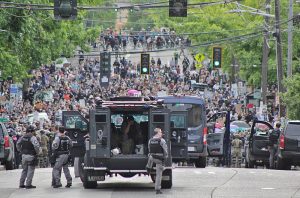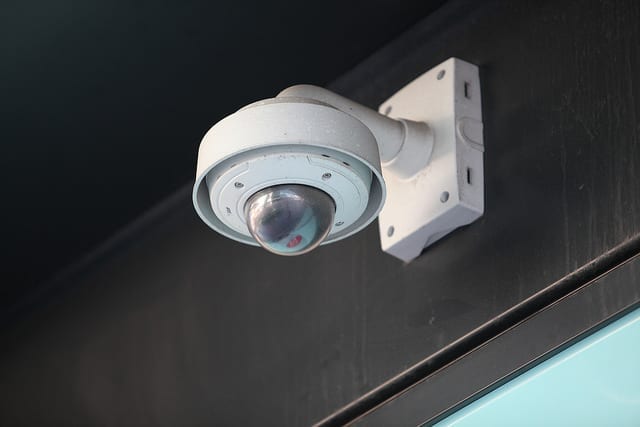People involved in protests, should expect that there is limited, or no, privacy when partaking in their constitutional right to assemble.
Facial recognition technology has moved from science fiction to nonfiction in the last decade. From unlocking your smartphone, to potentially implicating you in a crime, government law enforcement along with state and local entities are using facial recognition technologies to help identify criminals and protestors. But what if an individual is peacefully protesting and exercising their First Amendment rights guaranteed as Americans?
Some individuals participating in the recent Portland protests have been detained by unmarked enforcement officials and escorted into unmarked vehicles. Much to the alarm of civil rights lawyers and criminal defense attorneys. This crackdown, and similar crackdowns, presents the following question.
Does the government have the authority to identify individuals for acts of peaceful protests and detain these individuals? Let’s examine.
Facial Recognition & Biases
Facial recognition has evolved from works of Orwellian literature to works of government policy. Technology has created many benefits for the average individual, but with each technological innovation, there is potential for governments to use the technology against their own citizens.
Generally speaking, facial recognition technology has been used to outline and potentially identify a suspect involved in a crime by law enforcement. However, CBS news reports that there is an inherent bias associated with much of the available facial recognition technologies available to law enforcement. Facial recognition technology tends to have a bias towards minorities in a given population. For example, in China, facial recognition technology has a high success rate for Asian individuals but has a difficult time correctly identifying non-Asian individuals. In the United States, facial recognition has a high success rate with Caucasian individuals, but fails to properly implement the same successful recognition on individuals that are not of Caucasian descent.
Essentially facial recognition is biased towards individuals not from the dominant nation of people from a given country. Many facial recognition algorithms can properly identify an individual with a high success rate, but when that algorithm and technology are used on people within a minority population, it fails to provide a comparable success rate.
No facial analysis system is accurate one hundred percent of the time, and the amount of accuracy is largely based on the locality where the technology was developed. Even juggernauts in the tech space, like Amazon, incorrectly identify celebrities from minority populations as members of the opposite sex. Rekognition, Amazon’s face technology, once incorrectly identified Oprah Winfrey as a man. It then was unable to identify more than two dozen members of the US Congress to a mugshot database. This is obviously concerning and can lead to false identifications and improper arrests.
Additionally, an MIT study found that Microsoft, IBM and Face++ had much higher success rates identifying males with lighter skin opposed to women with darker complexions. The lack of different complexions has led to a bias in facial recognition.
Facial Recognition at Protests
Protesting is an American institution. Members of the American Revolution were actively involved in protests and acts of dissidence. The authors of the US Constitution had such high esteem for peaceful assembly they put this amendment first in the Bill of Rights. The First Amendment guarantees the following protections:
The First Amendment
Congress shall make no law respecting an establishment of religion, or prohibiting the free exercise thereof; or abridging the freedom of speech, or of the press; or the right of the people peaceably to assemble, and to petition the government for a redress of grievances.
However, individuals who have recently partaken in the massive BLM protests across the United States may have had their facial compositions mapped and added to a database. According to the Guardian, at least one in four police offices in this country utilize facial recognition technologies.

The Fourth Amendment
The Fourth Amendment guarantees against illegal searches and seizures. It states the following:
The right of the people to be secure in their persons, houses, papers, and effects, against unreasonable searches and seizures, shall not be violated, and no Warrants shall issue, but upon probable cause, supported by Oath or affirmation, and particularly describing the place to be searched, and the persons or things to be seized.
Law enforcement has been using data collected via drones and street cameras to cross reference with facial recognition technology already collected. These entities have collected data through cameras and drones, along with cell phone data, to analyze where protests are occurring and who is partaking in these protests. People involved in protests, should expect that there is limited, or no, privacy when partaking in their constitutional right to assemble.
The Fourth Amendment guarantees these rights, but with the ever evolving technological landscape, loopholes exist.
Violations of an individual’s protected rights can have dangerous repercussions in both the western hemispheres and eastern hemispheres.
Protests in Hong Kong
When we compare and contrast the fall of Special Status, one country two systems, for Hong Kong, we see numerous cases of political dissidents being targeted by mainland China. Their crimes in question can have penalties of up to life in prison. The crackdown on political dissidence has escalated so quickly, that the United Kingdom has stated that up to three million Hong Kong citizens can settle in the UK, and ultimately apply to become citizens. Is this microcosm a precursor for things to come for political dissidents in the United States?
It is entirely within the realm of possibility that individuals that have been identified using facial recognition technologies could have legal repercussions levied against them for participating in their First Amendment right to peacefully assemble.
A Wrongful Arrest in Michigan
Robert Williams, an African American man in Michigan, was wrongfully accused of a crime that he did not commit. The police officers called his wife Melissa, alerting her that her husband was wanted for as a suspect in a crime. The officers offered no additional information regarding the crime in question, and after Mr. Williams did not surrender to the authorities, law enforcement showed up at his house.
The crime in question involved an individual who stole five wrist watches from a Shinola retail store. Detroit PD say the criminal took about $3,800 worth of watches from the store.
After cross referencing the suspect on CCTV with a facial recognition software. The pixelated image came back with a match of Robert Williams.
Detroit Police handcuffed Robert on his front lawn in front of his young girls – aged two and five. Apart from the traumatic experience this can cause children, Robert maintained his innocence. The Detroit PD held Robert for a day plus attempting to get a guilty plea. He continued to maintain his innocence, eventually the arresting officers acknowledged that “the computer must have gotten it wrong”.
That statement is truly terrifying when put into context. The police officers involved in investigating a crime, with salaries funded by taxpayer dollars, relied on a computer to do the actual investigation. If the officers had of investigated social media outlets of the suspect, they would found Mr. Williams indeed had an alibi and was not at the scene of the crime. Had the officers investigated the social media they would have seen the alibi. He was live streaming content to his Facebook account at the time of the crime.
But the officers did not investigate his social media accounts, or wardrobe, and instead a different series of events transpired. Robert Williams was incorrectly identified by Detroit PD. He was not asked if he owned any of the attire the actual suspect was wearing. The suspect in question was wearing a red St. Louis baseball hat. According to Phil Mayor of the ACLU:
“They never even asked him any questions before arresting him. They never asked him if he had an alibi. They never asked if he had a red Cardinals hat. They never asked him where he was that day.”
Eventually Mr. Williams was released without injury, but the fallout from this wrongful arrest may follow him for years to come. Civil rights activists point to this case as the first documented example of an individual in the United States being wrongfully arrested as a result of a false match via facial recognition technology. Although this case was the first, one must ask themselves – how many more individuals will be wrongfully arrested like Mr. Williams as a result of a computer getting it wrong?
Conclusion
In the years leading up to 2020, facial recognition has been used to target political dissidents in countries in the eastern and western hemispheres. Rights previously guaranteed, with activists’ identities remaining anonymous, have now been compromised. 2020 has opened the floodgates for many firsts. It is important to be cognizant of this in 2020 and in the future.
There have been many firsts for many in 2020, from the right to peacefully assemble guaranteed by the First Amendment, and the first example of a wrongful arrest as a result of facial recognition technology. In a year of many firsts, we need to take a step back and question why this is happening in the United States. Exercising your right to peacefully assemble should not implicate you in a potential crime or unknowingly be added to a facial recognition database.
Facial recognition has been used to crack down on dissidence in both the East and West. Especially in regards to minority communities. As of now, it appears that governments have the authority to detain individuals, but the legality of this has been, and will continue to be, challenged.


Join the conversation!